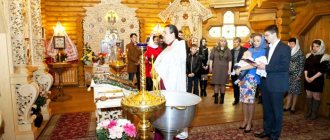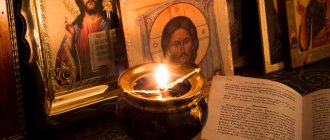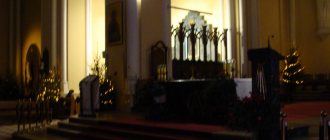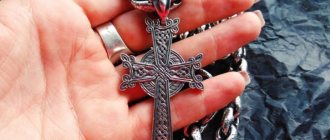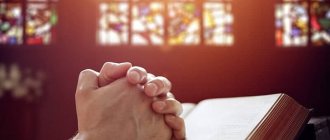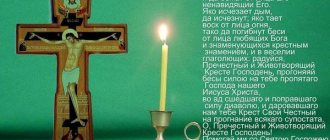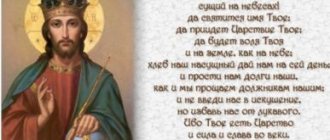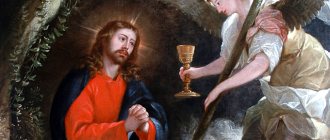Every novice Orthodox Christian should know the important, most basic prayers and read them at home, on the road, at all critical moments of his life. Although, rather, every person should know them for
People who visit the temple during the liturgy, during ordinary worship, know which prayers should be read and in what order. Things are different for those who begin a conversation with God, for those who take the first steps on the path of faith. What are the main prayers and what are the secondary ones? Of course, there is no such division; any prayer is a conversation with God. But there are those that are considered basic.
So, the main prayers for an Orthodox Christian. These conversions are the beginning of all beginnings, the basis of the foundations of Christianity.
Prayer "Our Father"
The main questions that sooner or later a neophyte asks: where did these or those prayers come to us? Why is “Our Father” the main prayer of the Orthodox? On what occasions are the main prayers read?
Let's start with the first question. In particular, let's find out the origin of the Lord's Prayer.
She is mentioned in the Gospels of Matthew and Luke. Jesus Christ himself commands this prayer to his disciples and all Christians. Reading it, we turn to the Heavenly Father, calling on His name.
Prayer text
What does one of the main Orthodox prayers sound like? Like this:
Our Father, who art in Heaven. Hallowed be Thy name, Thy kingdom come. Thy will be done as it is in heaven and on earth. Give us this day our daily bread. And forgive us our debts, just as we forgive our debtors. And do not lead us into temptation. But deliver us from evil. Amen!
It would seem like a short prayer. I quickly read it and ran to do my own thing. But listen to these words, delve into the essence of the text.
We glorify God and humbly submit ourselves to His lordship. That is, we accept God’s will for ourselves. This is what we testify to in prayer. We turn to the Heavenly Father. And He will give us what we need. You just need to pray and ask.
Basic prayers.
Prayer Our Father
Our Father, who art in heaven!
Hallowed be Thy name,
May your kingdom come
Thy will be done as it is in heaven and on earth.
Give us this day our daily bread;
And forgive us our debts, just as we forgive our debtors;
And do not lead us into temptation,
But deliver us from evil.
Our heavenly Father! May everyone glorify and love You! May Your Kingdom come, may Your will be fulfilled on earth by people as it is now being fulfilled by Angels in Heaven! Give us what we need to maintain life! Forgive us for what we are guilty of before You, just as we forgive those who are guilty of us! Do not let us fall into sin and deliver us from the evil one (i.e. from the evil force, Satan).
This prayer is called the Lord's Prayer because the Lord Jesus Christ Himself taught it to us. This is how it was told about it in the Gospel (Luke 11:1-4):
It happened that when He (the Lord) was praying in one place and stopped, one of His disciples said to Him: Lord! Teach us to pray, as John taught his disciples.
He said to them: when you pray, say: Our Father. and taught them this prayer.
Symbol of Faith. (Under each point there is an interpretation in Russian)
1. I believe in one God, the Father, Almighty, Creator of heaven and earth, visible to all and invisible. I believe in one God, the Father, Almighty, Creator of heaven and earth, of everything visible and invisible.
2. And in one Lord Jesus Christ, the Son of God, the only begotten, who was born of the Father before all ages; Light from Light, true God from true God, born, uncreated, consubstantial with the Father, to Whom all things were. And in one Lord Jesus Christ, the Son of God, the Only Begotten, begotten of the Father before all ages: Light from Light, true God from true God, begotten, not created, one being with the Father, by Him all things were created.
3. For our sake, man and our salvation came down from heaven and became incarnate from the Holy Spirit and the Virgin Mary, and became human. For the sake of us people and for the sake of our salvation, He came down from heaven, and took flesh from the Holy Spirit and the Virgin Mary, and became human.
4. She was crucified for us under Pontius Pilate, and suffered and was buried. He was crucified for us under Pontius Pilate, and suffered, and was buried.
5. And he rose again on the third day according to the Scriptures. And rose again on the third day according to the Scriptures.
6. And ascended into heaven, and sits at the right hand of the Father. And ascended into heaven, and sits at the right hand of the Father.
7. And again the coming one will be judged with glory by the living and the dead, His Kingdom will have no end. And He will come again with glory to judge the living and the dead; His Kingdom will have no end.
8. And in the Holy Spirit, the Lord, the Life-Giving One, who proceeds from the Father, who is with the Father and the Son, is worshiped and glorified, who spoke the prophets. And in the Holy Spirit, the Lord, the giver of life, who proceeds from the Father, worshiped and glorified with the Father and the Son, who spoke through the prophets.
9. Into one Holy, Catholic and Apostolic Church. Into one holy, catholic and apostolic Church.
10. I confess one baptism for the remission of sins. I recognize one baptism for the forgiveness of sins.
11. I look forward to the resurrection of the dead, I look forward to the resurrection of the dead,
12. and the life of the next century. Amen. and the life of the next century. Amen (truly so).
What is the meaning of this prayer?
“Our Father” refers to Orthodox prayers for all occasions. Whether we are gnawed by fear, confusion, despondency, we turn to God. And we ask for help.
What is the main essence of prayer? Striving towards God is the meaning. Acceptance that everything is from God, everything is from Him.
And all we have to do is just a little: pray, ask and believe the Heavenly Father. See how deep the meaning of prayer is. God gives everything, gives freely. And we can ask Him even for something as small as food. Although this is slightly un-Christian, since the Son of God left this prayer for people, it means it’s necessary.
Creeds in theology
Over the course of almost two thousand years of the existence of Christianity in the world, each Christian society has developed its own creeds. A new branch of theology has emerged - symbolism, which studies comparatively the symbols of faith of different faiths and with great success replaces the so-called polemical, or accusatory, theology of old times. Schleiermacher calls symbolism “comparative dogmatics,” Pelt calls it a means to “knowledge of the confessional principles of all faiths.”
Apostles' Creed
Main article: Apostles' Creed
The earliest creed to be given its own name was the Apostles' Creed. Christian tradition attributes it to all twelve apostles: supposedly each of them said one sentence of this symbol of faith. Such an attribution itself is hardly correct, but the Apostles' Creed is itself quite old; it was most likely compiled from the catechism used in adult baptism, and in this form it may have been compiled in the 2nd century. The Apostles' Creed was most likely formulated in opposition to Docetism and other similar ideas.
Nicene-Constantinopolitan Creed
Main article: Nicene-Constantinopolis Creed
Compiled by the First Ecumenical Council (Nicaea, Asia Minor) in 325 (see Nicene Creed); in 381 it was expanded and supplemented by the Second Ecumenical Council (Constantinople). Based on the names of the places where the councils took place, it received the name Nicene-Constantinople or Nicene-Constantinople Symbol. The Nicene-Constantinopolitan Creed inherited its main provisions from the Apostolic Creed. In addition, the First Ecumenical Council added provisions from Christology and the Trinity, which aimed to reject Arianism (in particular, by a separate decision, the First Ecumenical Council established that Arianism is a heresy).
The Nicene-Constantinopolitan Creed is used in both Orthodoxy and Catholicism. In the latter case, usually with the addition of “filioque” (indicating the descent of the Holy Spirit not only from God the Father, but “and from the Son”
). The filioque is obligatory in the Latin rite of the Catholic Church (except for the Greek language of worship), however, in a number of Eastern Catholic churches (for example, the Greek) the filioque is not used.
Other Christian Creeds
Among the rest of the many symbols of faith, the following can be distinguished:
- The Symbol or Statement of Faith by Gregory of Neocaesarea;
- Afanasyevsky Creed;
- Chalcedonian Creed;
- The Tridentine Creed is the Catholic Creed adopted at the Council of Trent;
- Creed of the People of God by Pope Paul VI, (1968);
- Augsburg Confession of 1530;
- 39 articles - confession of the Anglican Church;
- Creed of the Methodist Church.
Holy Mother of God, save us
How beautifully the prayer sounds: “Virgin Mother of God, rejoice. Blessed Mary, the Lord is with you...” Do you know her story?
Everyone knows about the Feast of the Annunciation. On this day, Archangel Gabriel brought the Good News to the Immaculate Young Lady. She will become the Mother of the Son of God.
The life of the Mother of God is the Christian ideal. The Queen of Heaven had no sins. From an early age She was sent to the temple, where she lived. Studying the Holy Scriptures, Mary knew the prophecy about the birth of the Savior. She dreamed of becoming at least a servant of His Mother. When the Archangel informed Mary that She was the chosen one, the Virgin obediently accepted the will of God.
But what does prayer have to do with it? If we turn to the Gospel episode, which tells about Gabriel’s visit to the Mother of God, there are words of appeal to Her. And these words of the Archangel formed the basis of one of the main Orthodox prayers.
Creed Prayer
The Creed Prayer is read in the morning and evening prayer rules, and is also sung in church together with parishioners during the Liturgy of the Faithful (this is one of the parts of the Divine Liturgy - the morning church service). Although the Creed does not contain appeals to God, the Mother of God, the Guardian Angel or the saints, as well as thanksgiving or repentance, it is considered a prayer and is found in any prayer book.
For the sacrament of baptism, the Creed is the main provision. The godmother or godfather needs to know this prayer, because it is read at the entrance to the temple of God and during the process of the sacrament itself. The priest reads a prayer at the very beginning and end of the ritual. During home preparation for baptism, it is worth remembering that if the baby is a girl, then the Creed is read by the godmother, and if it is a boy, then by the godfather.
We recommend studying the Bible
If an adult is preparing for the sacrament of baptism, he reads this prayer himself. For this reason, it is necessary that at least one of the godparents memorize the Creed. Although the church may allow you to read a prayer from your own preparation or from a prayer book, in this case you need to be careful and think about the meaning.
It is generally accepted that prayer is an appeal to God or patron saints with a request or gratitude. There are prayers and psalms, generally accepted among Christians, established by the church, which, when read with faith, have great power.
However, a person can communicate with the Almighty, with the Mother of God or with his saints, without using the ancient texts of prayers. One way or another, any prayer is imbued with faith, which a person often loses in desperate attempts to get out of a difficult situation.
In this state, they often give in to despondency and give up, believing that the Holy Heavens have left them without help. The prayer book “Symbol of Faith” restores strength, helps to restore hope and faith in God, in his help. We can say that this is an appeal to oneself, reminding that Higher Powers exist and they will help, that one should not lose faith. The text of the prayer does not directly address God, but it is talked about.
Since the content of the prayer is based on the dogmas of Orthodox Christian teaching, all the truths are briefly presented in it. Context contains the meaning of faith. The prayer itself begins with the word “I Believe,” which is the key to returning to unity with God. This word has great power, which removes all doubts from the consciousness of the person praying and returns knowledge of the truth, filling the mind with hope.
If we interpret the words of the prayer in an understandable language, then in continuation we are talking about the fact that God is one and everything that exists - man himself and around him - is a divine creation - “...visible to all and invisible.”
This is followed by a mention of Jesus Christ, the only begotten son, born of the Holy Spirit and the Virgin Mary, who suffered and rose again “... on the third day according to the scriptures” for the good of man, and then ascended to heaven to help people. Thinking about the meaning of prayer, you gradually come to the realization that nothing is easy right away, changes will not happen if you lose your mind.
Whatever the request of the person praying, it will be heard and help will come, you just need to be patient and continue to live. This is exactly how the prayer ends, consolidating faith in the mind: “... the tea of the resurrection of the dead and the life of the next century,” in other words, life continues.
The Creed of Orthodox Christians strengthens a person’s spiritual strength, which means it should be read as often as possible.
Prayer text
For those who do not know the prayer “Rejoice to the Virgin Mary,” we publish its text:
Virgin Mary, rejoice! Blessed Mary, the Lord is with you. Blessed are You among women and blessed is the Fruit of Your womb. For she gave birth to the Savior, who art our souls.
By the way, if you go to Diveevo, be sure to walk along the groove of the Virgin Mary, while reading this prayer. You need to read it 150 times. Even the Monk Seraphim of Sarov said that those who read the Theotokos rule daily are found under the Protection of the Queen of Heaven. What is the “Mother of God Rule”? This is the prayer “Rejoice, Virgin Mary,” read 150 times.
"Symbol of faith"
One of the main prayers of Orthodox Christians is the “Symbol of Faith.” Rather, this is not even a prayer, because there is no appeal to God and the Mother of God here. The “Creed” is a confession of faith.
It consists of 12 parts. These are dogmas that contain the truth of the Orthodox faith.
By reading the Creed, we testify that we believe in the Trinity of God. In God the Father, who has always existed, in God the Son, who is the bearer of the same essence as the Father, but took incarnation into a human body for the sake of our salvation. At the same time, He did not cease to be God.
Jesus Christ was crucified. That is, He died, was buried, and rose again on the third day after His burial. After the resurrection, the Savior ascended to Heaven, to His Father. And now it is there.
The time will come when the Son of God will come to earth again. This will be the Second Coming of Christ. This time He acts as a Judge of the human race. There will be a Last Judgment, and the dead will rise to appear before the Judge. At the Judgment there will be a separation of the righteous from the sinners. The former are destined for heaven, and the latter will go to hell. After which new life will come on earth.
Prayer I believe symbol of faith text
1 I believe in one God, the Father, Almighty, Creator of heaven and earth, visible to all and invisible. 2 And in one Lord Jesus Christ, the only Son of God, begotten of the Father before all ages; Light from Light, true God from true God, born, uncreated, consubstantial with the Father, to Whom all things were. 3 For our sake, man and our salvation came down from heaven and became incarnate from the Holy Spirit and the Virgin Mary, and became human. 4 She was crucified for us under Pontius Pilate, and suffered and was buried. 5 And he rose again on the third day according to the Scripture. 6 And ascended into heaven, and sits at the right hand of the Father. 7 And the one who is to come will judge with glory the living and the dead, whose kingdom will have no end. 8 And in the Holy Spirit, the Lord, the Life-Giving One, who proceeds from the Father, who is with the Father and the Son, is worshiped and glorified, who spoke the prophets. 9 Into one Holy, Catholic and Apostolic Church. 10 I confess one baptism for the remission of sins. 11 I look forward to the resurrection of the dead, 12 and the life of the world to come. Amen.
To believe in God means to have living confidence in His being, properties and actions and to accept with all your heart His revealed word about the salvation of the human race. God is one in essence, but trinity in Persons: Father, Son and Holy Spirit, the Trinity is consubstantial and indivisible. In the Creed, God is called Almighty, because He contains everything that is in His power and His will. The words of the Creator to heaven and earth, to those visible to all and to those invisible, mean that everything was created by God and nothing can exist without God. The word invisible indicates that God created the invisible, or spiritual, world to which the Angels belong.
The Holy Spirit is called Lord because he, like the Son of God, is true God. The Holy Spirit is called Life-Giving, because He, together with God the Father and the Son, gives life to creatures, including spiritual life to people: unless someone is born of water and the Spirit, he cannot enter the Kingdom of God (John 3:5). The Holy Spirit proceeds from the Father, as Jesus Christ Himself says about this: When the Comforter comes, whom I will send to you from the Father, the Spirit of truth, which proceeds from the Father, He will testify about Me (John 15:26). Worship and glorification befits the Holy Spirit, equal to the Father and the Son - Jesus Christ commanded to baptize in the name of the Father and the Son and the Holy Spirit (Matthew 28:19). The Creed says that the Holy Spirit spoke through the prophets - this is based on the words of the Apostle Peter: prophecy was never pronounced by the will of man, but holy men of God spoke it, being moved by the Holy Spirit (2 Pet. 1:21). You can become a participant in the Holy Spirit through the sacraments and fervent prayer: if you, being evil, know how to give good gifts to your children, how much more will the Heavenly Father give the Holy Spirit to those who ask Him (Luke 11:13).
The Church is one because there is one body and one spirit, just as you were called to one hope of your calling; one Lord, one faith, one baptism, one God and Father of all, who is above all, and through all, and in us all (Eph. 4:4-6). The Church is Holy, because Christ loved the Church and gave Himself for her in order to sanctify her, cleansing her with the washing of water through the word; in order to present it to Himself as a glorious Church, not having spot, or wrinkle, or any such thing, but that it might be holy and without blemish (Eph. 5:25-27). The Catholic Church, or, which is the same thing, catholic, or Ecumenical, because it is not limited to any place, time, or people, but includes true believers of all places, times and peoples. The Church is Apostolic, because it has continuously and invariably preserved since the time of the apostles both the teaching and the succession of the gifts of the Holy Spirit through consecrated ordination. The True Church is also called Orthodox, or True Believers.
We advise you to study What is lithium in Orthodoxy?
Baptism is a Sacrament in which a believer, by immersing his body three times in water, with the invocation of God the Father, the Son, and the Holy Spirit, dies to a carnal, sinful life and is reborn from the Holy Spirit into a spiritual, holy life. Baptism is one, because it is a spiritual birth, and a person is born once, and therefore is baptized once.
The resurrection of the dead is an action of the omnipotence of God, according to which all the bodies of dead people, uniting again with their souls, will come to life and will be spiritual and immortal.
The life of the future century is the life that will happen after the Resurrection of the dead and the General Judgment of Christ.
The word Amen, which completes the Creed, means “Truly so.” The Church has kept the Creed since apostolic times and will keep it forever. No one can ever subtract or add anything to this Symbol.
Text of the Creed
The “Symbol of Faith” refers to the main prayers of the Orthodox every day. It is in the morning sequence. And at every liturgy the “Creed” is sung:
I believe in One God - the Almighty Father. Creator of Heaven and earth, visible to all and invisible. And in the One Lord Jesus Christ - the Son of God. The only begotten, who was born of the Father before all ages. Light from Light, true God from true God. Born, uncreated, consubstantial with the Father, by whom all things were.
For our sake, Man came down from Heaven for our salvation. And became incarnate from the Holy Spirit and the Virgin Mary, and became human.
Crucified for us under Pontius Pilate. And suffered, and was buried, and rose again on the third day according to the Scriptures.
And entered into Heaven, and sits at the right hand of the Father. And again you will judge the future with glory, living and dead. His Kingdom will have no end.
And in the Holy Spirit, the life-giving Lord, who proceeds from the Father. And together with the Father and the Son we worship and glorify the prophets who spoke.
Into One Holy Catholic and Apostolic Church. I confess one Baptism for the remission of sins.
Tea of the Resurrection of the Dead. And the life of the next century. Amen
It is believed that if a dying person reads the Creed, he will go straight to God, without going through ordeals.
Prayer to the Guardian Angel - text
. Holy Angel of Christ, I fall to pray to you, my holy guardian, given to me for the protection of my sinful soul and body from holy baptism, but with my laziness and my evil custom I angered your most pure lordship and drove you away from me with all the cold deeds: lies, slander , envy, condemnation, rebellion; brotherly hatred and resentment; love of money, adultery, rage, stinginess, gluttony without satiety, excessive talking, evil thoughts and craftiness, and proud customs, with self-lust for all carnal lust. Oh, my evil will, which even dumb animals cannot do! Yes, how can you look at me; or come to me, with whose eyes, the Angel of Christ, look at me, entangled in evil in vile deeds? How can I already ask for forgiveness with my bitter and evil and crafty deed, I fall into misery all day and night and at every hour? But I pray to you, falling down, my holy guardian, have mercy on your sinful and unworthy servant (name), be me a helper and intercessor against the evil of my opponent, with your holy prayers, and make me a partaker of the Kingdom of God with all the saints, and forever. Amen.
Guardian Angel is an Angel who, according to Sacred Tradition, is assigned to every person from birth to help him in good deeds. The Lord uses the help of the Guardian Angel not because he needs it, but out of His goodness, giving them a part in the fulfillment of His Providence.
He instructs these blessed spirits to protect the righteous (Ps. 90:11-13; Heb. 1:14); thwart the machinations of demons (Tov. 8, 3); lift up people’s prayers to God (Tov. 12:12); take the soul to the afterlife (Luke 16:22); To them He entrusts the task of separating the good from the evil at the Last Judgment (Matthew 13:49).
The first Christians already had faith in Guardian Angels. When the Apostle Peter, miraculously freed from prison, appeared to Christians, they were surprised and said to each other that this was his Angel (Acts 12:15). The Savior Himself confirmed this belief, saying that the Angels “of these little ones... in heaven always see the face of My Heavenly Father” (Matthew 18:10).
What's the point?
What is the meaning of the Creed prayer?
This is a statement of the fundamental teachings of the Orthodox faith. Brief, precise and approved by the First and Second Ecumenical Councils. That is why it is also called Niceno-Constantinograd. In honor of the places where meetings of the Councils took place.
Do you know why there was a split between Orthodox and Catholics? The thing is that in the 11th century Catholics decided to make a change to the text of the prayer. A single word led to differences of opinion. What is it like? "Son." Catholics in the line “And in the Holy Spirit, the Lord who gives life, who proceeds from the Father,” added the word “Son” after “Father.” As a result, it turned out that the Holy Spirit comes from the Father and the Son. The Orthodox completely disagreed with this. This is how the split arose.
Basic prayers.
Prayer Our Father
Our Father, who art in heaven!
Hallowed be Thy name,
May your kingdom come
Thy will be done as it is in heaven and on earth.
Give us this day our daily bread;
And forgive us our debts, just as we forgive our debtors;
And do not lead us into temptation,
But deliver us from evil.
Our heavenly Father! May everyone glorify and love You! May Your Kingdom come, may Your will be fulfilled on earth by people as it is now being fulfilled by Angels in Heaven! Give us what we need to maintain life! Forgive us for what we are guilty of before You, just as we forgive those who are guilty of us! Do not let us fall into sin and deliver us from the evil one (i.e. from the evil force, Satan).
This prayer is called the Lord's Prayer because the Lord Jesus Christ Himself taught it to us. This is how it was told about it in the Gospel (Luke 11:1-4):
It happened that when He (the Lord) was praying in one place and stopped, one of His disciples said to Him: Lord! Teach us to pray, as John taught his disciples.
He said to them: when you pray, say: Our Father. and taught them this prayer.
Symbol of Faith. (Under each point there is an interpretation in Russian)
1. I believe in one God, the Father, Almighty, Creator of heaven and earth, visible to all and invisible. I believe in one God, the Father, Almighty, Creator of heaven and earth, of everything visible and invisible.
2. And in one Lord Jesus Christ, the Son of God, the only begotten, who was born of the Father before all ages; Light from Light, true God from true God, born, uncreated, consubstantial with the Father, to Whom all things were. And in one Lord Jesus Christ, the Son of God, the Only Begotten, begotten of the Father before all ages: Light from Light, true God from true God, begotten, not created, one being with the Father, by Him all things were created.
We advise you to study the Icon of the Mother of God “Addition of Mind”
3. For our sake, man and our salvation came down from heaven and became incarnate from the Holy Spirit and the Virgin Mary, and became human. For the sake of us people and for the sake of our salvation, He came down from heaven, and took flesh from the Holy Spirit and the Virgin Mary, and became human.
4. She was crucified for us under Pontius Pilate, and suffered and was buried. He was crucified for us under Pontius Pilate, and suffered, and was buried.
5. And he rose again on the third day according to the Scriptures. And rose again on the third day according to the Scriptures.
6. And ascended into heaven, and sits at the right hand of the Father. And ascended into heaven, and sits at the right hand of the Father.
7. And again the coming one will be judged with glory by the living and the dead, His Kingdom will have no end. And He will come again with glory to judge the living and the dead; His Kingdom will have no end.
8. And in the Holy Spirit, the Lord, the Life-Giving One, who proceeds from the Father, who is with the Father and the Son, is worshiped and glorified, who spoke the prophets. And in the Holy Spirit, the Lord, the giver of life, who proceeds from the Father, worshiped and glorified with the Father and the Son, who spoke through the prophets.
9. Into one Holy, Catholic and Apostolic Church. Into one holy, catholic and apostolic Church.
10. I confess one baptism for the remission of sins. I recognize one baptism for the forgiveness of sins.
11. I look forward to the resurrection of the dead, I look forward to the resurrection of the dead,
12. and the life of the next century. Amen. and the life of the next century. Amen (truly so).
How to pray in temple?
We know that there are Orthodox prayers for all occasions. The most basic ones are “Our Father”, “Rejoice to the Virgin Mary” and “Creed”.
How to pray correctly? There are two options:
- At home.
- In the temple.
Most often we read all three prayers when we pray in the morning. They are in the morning rule.
In church, during the liturgy, two prayers are read: “Our Father” and “Creed.” More precisely, they are sung by the entire temple. First - the “Symbol of Faith”, after which the most difficult and terrible (let’s not be afraid of this word) part of the service begins. The Eucharistic canon, when the Body and Blood of Christ is transformed into bread and wine. In the altar, the priest reads prayers, performs special actions, and at this time the choir sings “The Grace of the World.”
The Eucharist ends with the Lord's Prayer. This is followed by the removal of the Chalice and communion.
Baptismal prayers you need to know
So, adults and godparents preparing for Baptism must definitely know the prayers “Our Father”, “Rejoice to the Virgin Mary” and meaningfully read the “Creed”. During the sacrament, the priest reads the prayers, but the godparents must repeat these prayers after him.
Regardless of whether it is the christening of a boy or a girl, godparents also need to know the prayer to the Holy Spirit “Heavenly King” and the Most Holy Theotokos “It is worthy to eat.”
Prayer to the Holy Spirit “Heavenly King”
Heavenly King, Comforter, Soul of truth, Who art everywhere and fulfills all things, Treasure of good things and Giver of life, come and dwell in us and cleanse us from all filth, and save, O Good One, the souls of sha.
Prayer to the Most Holy Theotokos “It is worthy to eat”
It is worthy to eat, as you are truly blessed, the Mother of God, the Ever-Blessed and Most Immaculate and the Mother of our God. We magnify Thee, the most honorable Cherub and the most glorious without comparison, the Seraphim, who gave birth to God the Word without corruption.
How to pray at home?
No one has yet canceled the main prayer of the Orthodox at home. And it is not at all necessary to pray only in the morning. Is there a need? Turn to God and the Mother of God. Read the three prayers listed above.
In general, it is very useful to pray during the day. In the morning we got up and read the rules. During lunch you can read “Rejoice to the Virgin Mary.” With thoughtful and deep reading, 150 prayers take an hour. If you read quickly, then from 20 to 30 minutes. Quite capable, right?
Let's take a little break from home prayer. When to read the Mother of God rule if there is no time at all? In the morning we got up, pushed the family away from work and school, quickly ate and ran to work. And at work - one continuous bustle. Where can I pray?
We arrived home in the evening. And so it began: in a few hours we need to get a lot of things done. Again, no time for prayer.
Stop. How are we going to work? By car, as a rule. And we listen to music. Music can be replaced with prayer. And we got to work and prayed.
On public transport, read the prayer mentally. Instead of plugging your ears with headphones and playing music.
Now let's get back to home prayer. You can do household chores and pray. Or you can stand in front of the icons, light the lamp and offer your prayer to God and the Mother of God.
Is preparation necessary?
The main prayer of Orthodox Christians is in their hearts. Don’t be surprised, because you can read several akathists thinking about something completely different. That is, lips read, but thoughts wander.
Or you can read only three prayers, but from the bottom of your heart. And it will be more useful for the one asking.
How can we pray at home? What does this require? Let's say step-by-step instructions will help:
- Light a lamp or candle in front of the icons.
- A woman must cover her head with a scarf. Men remain bareheaded.
- As for the dress code, this is a controversial issue. The ideal option for the fairer sex is a skirt. But if you can't wear a skirt, trousers will do. The main thing is no shorts and, of course, you can’t get up for prayer in your underwear.
- Shorts are not allowed for men. Trousers and only trousers.
- Cross yourself slowly, no one is pushing you anywhere.
- Start reading the prayer. Thoughtfully, without haste. From the bottom of my heart, as they say.
- Have you prayed? Now you can ask for what you prayed for.
No difficulties, as you can see. Everything is extremely simple and does not take much time.
